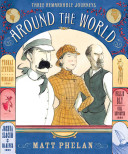
As the nineteenth century wound down, a public inspired by Jules Verne’s novel Around the world in Eighty Days clamored for intrepid adventure. The challenge of circumnavigating the globe as no one ever had before attracted toe fearless in droves. Three hardy spirits stayed the course. In 1884, former miner Thomas Stevens made the journey on a bicycle…the kind with a big front wheel. In 1889, pioneer reporter Nellie Bly embarked on a global race against time that assumed the heights of spectacle. And in 1895, retired sea captain Joshua Slocum quietly set sail on a thirty-six-foot sloop named the Spray, braving pirates and treacherous seas to become the first person to sail around the world alone.
With cinematic pacing and deft, expressive art., acclaimed graphic novelist Matt Phelan weaves a trio of epic journeys into a single bold tale of three visionaries who set their sights on nothing short of the world.
- ISBN: 9780763636197
- Published: 2011 , Candlewick Pr
- Themes: Adventure, challenge, race, Voyages and travels
- Descriptors: Graphic Novel, Intermediate (ages 9-14), International, Nonfiction
- No. of pages: 240

I found this book to be a powerful reminder of how our world has changed. Phelan’s graphic novel fictionalizes the around the world journeys of three real people: Thomas Stevens, Joshua Slocum and Nellie Bly. At the end of the nineteenth century people were inspired by Jules Verne’s novel Around the World in Eighty Days. The three adventurers in this book decided to circumvent the globe based on the public interest in that feat. The world travels of Stevens, Slocum and Bly were very different. Stevens, a miner, made the journey in 1884, on bicycle with a 50-inch wheel. Bly, a reporter for the newspaper, The World, raced a rival reporter around the world in 1889 on ocean liners and trains. Bly won! “Her journey lasted seventy-two days, six hours, eleven minutes and fourteen seconds.” Slocum decided to sail around the world on a thirty-six-foot sloop in 1895. He became the first person to sail around the world alone. Phelan emphasizes why Stevens, Slocum and Bly undertook their journeys. He writes in the Author’s Note, “The public journeys (a straightforward presentation of events) began to shift to the private journeys (my interpretation of these events). My journey for Around the World started down one path but reached a different and surprising destination. … Isn’t that how all good journeys should end?” Phelan’s note affirmed for me that journeys can take many forms. My journey through reading this book provided new information, inspiration and an adventure all without leaving my comfortable chair.